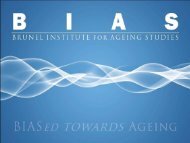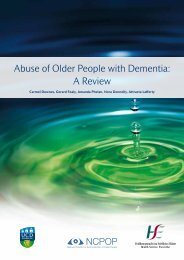Public Perceptions of Older People A literature review
Review 1 PP OP.pdf - National Centre for the Protection of Older ...
Review 1 PP OP.pdf - National Centre for the Protection of Older ...
You also want an ePaper? Increase the reach of your titles
YUMPU automatically turns print PDFs into web optimized ePapers that Google loves.
wheelchairs as being associated with old age. To a lesser extent sensory<br />
deficits such as being chronically hard <strong>of</strong> hearing have also been associated<br />
with old age (Musaiger & D’Souza 2009). Falchikov’s (1990) study involving<br />
sketches drawn by 10 and 11 year olds found that <strong>of</strong> a third <strong>of</strong> the pictures <strong>of</strong><br />
old men included hearing aids. Similarly, Barrett and Cantwell (2007) found<br />
that thirty-five per cent <strong>of</strong> student sketches <strong>of</strong> older people included visioncorrecting<br />
glasses.<br />
Musaiger and D’Souza (2009) presented findings which are contrary to the<br />
popular perception that older people live out their retirement in ill-health and<br />
physically dependent. For example, only 1.6% <strong>of</strong> respondents in a sample <strong>of</strong><br />
305 Kuwaiti adults aged between 20 and 64 years believed that older people<br />
require a geriatric home. This may indicate positive attitudes towards care for<br />
the older person. However it may also be reflective <strong>of</strong> cultural beliefs about<br />
caring for older people within the family. Findings also reported positive<br />
perceptions regarding the ability <strong>of</strong> the elderly to travel alone which indicates<br />
respect for the desire <strong>of</strong> older people to live independently (Musaiger &<br />
D’Souza 2009).<br />
Overall it is evident from the <strong>literature</strong> on the public’s perceptions <strong>of</strong> ageing<br />
that older people are predominantly associated with poor health and are<br />
generally perceived as weak and frail. <strong>Older</strong> people are also characterised as<br />
having physical impairments, needing physical support aids as well as having<br />
declining eyesight and hearing. Although some evidence exists which indicates<br />
that older people are viewed as having the capacity to live long independent<br />
lives, the majority are stereotyped as becoming progressively frail and<br />
needing support as they get older. It is acknowledged that although the<br />
stereotypes <strong>of</strong> older people as weak, frail and disabled result from the ageing<br />
process and therefore have a basis in reality, some researchers have argued<br />
that it is not the experience <strong>of</strong> all older people and is <strong>of</strong>ten based more on<br />
myth than reality (Barrett & Pai 2008).<br />
7.5.1.2 Body image<br />
Other commonly held stereotypes <strong>of</strong> older people are associated with physical<br />
attributes and appearances. Facial appearances in particular have been<br />
reported as an important criterion for defining elderly people (Musaiger &<br />
D’Souza 2009). This has been found to be predominantly true for elderly<br />
women with about 60% <strong>of</strong> a sample <strong>of</strong> over 300 people considering facial<br />
15









